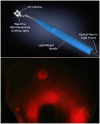Yttrium-90 Episcleral Plaque Brachytherapy for Choroidal Melanoma
- PMID: 38465362
- PMCID: PMC10924596
- DOI: 10.1177/24741264241227684
Yttrium-90 Episcleral Plaque Brachytherapy for Choroidal Melanoma
Abstract
Purpose: To describe the first use of high-dose-rate yttrium-90 disc brachytherapy for choroidal melanoma. Methods: A 72-year-old patient had a cT1-category choroidal melanoma characterized by the presence of orange pigment, increasing subretinal fluid (SRF), and enlarging tumor thickness. It was treated with single-session, light-guided, light-defined yttrium-90-disc brachytherapy. Results: A specialized handheld applicator provided with 4 encircling lights was used to guide plaque placement and localize treatment. Unlike low-dose-rate plaques, high-dose-rate yttrium-90 required only 3 minutes 39 seconds. In this case, treatment did not require episcleral sutures, muscle relocation, outpatient dwell time, or a second surgery. High-dose-rate treatment improved radiation safety by eliminating perioperative exposure to health care personnel, the community, and the family. At the 13-month follow-up, the SRF and tumor thickness were diminished. There was no secondary cataract, radiation retinopathy, maculopathy, or optic neuropathy, and the visual acuity was 20/20. Conclusions: Yttrium-90 brachytherapy allowed for single-surgery, minimally invasive, outpatient irradiation of a choroidal melanoma.
Keywords: brachytherapy; choroid; high-dose rate; melanoma; plaque; yttrium-90.
© The Author(s) 2024.
Conflict of interest statement
The author(s) declared the following potential conflicts of interest with respect to the research, authorship, and/or publication of this article: Dr. Finger is the chief executive officer of and owns private stock in LV Liberty Vision Corp and IP Liberty Vision Corp.
Figures




Similar articles
-
High-Dose-Rate Yttrium-90 (90Y) Episcleral Plaque Brachytherapy for Iris and Iridociliary Melanoma.Ophthalmol Sci. 2024 Mar 16;4(5):100513. doi: 10.1016/j.xops.2024.100513. eCollection 2024 Sep-Oct. Ophthalmol Sci. 2024. PMID: 38840779 Free PMC article.
-
First clinical implementation of Yttrium-90 Disc Brachytherapy after FDA clearance.Brachytherapy. 2023 May-Jun;22(3):416-427. doi: 10.1016/j.brachy.2023.02.004. Epub 2023 Mar 21. Brachytherapy. 2023. PMID: 36948988
-
Juxtapapillary and circumpapillary choroidal melanoma: globe-sparing treatment outcomes with iodine-125 notched plaque brachytherapy.Graefes Arch Clin Exp Ophthalmol. 2017 Sep;255(9):1843-1850. doi: 10.1007/s00417-017-3703-0. Epub 2017 Jun 9. Graefes Arch Clin Exp Ophthalmol. 2017. PMID: 28597076
-
Treatment of radiation retinopathy following plaque brachytherapy for choroidal melanoma.Curr Opin Ophthalmol. 2009 May;20(3):200-4. doi: 10.1097/ICU.0b013e328329b62d. Curr Opin Ophthalmol. 2009. PMID: 19349865 Review.
-
Ocular malignancies treated with iodine-125 low dose rate (LDR) brachytherapy at a single high-volume institution: A retrospective review.Med Dosim. 2022 Autumn;47(3):273-279. doi: 10.1016/j.meddos.2022.04.006. Epub 2022 May 26. Med Dosim. 2022. PMID: 35644778 Review.
Cited by
-
Allele-specific depletion of GNAQ Q209L via siRNA or an rAAV2-shRNA vector induces selective toxicity in GNAQ Q209L uveal melanoma cells.Mol Ther Oncol. 2025 Jul 17;33(3):201020. doi: 10.1016/j.omton.2025.201020. eCollection 2025 Sep 18. Mol Ther Oncol. 2025. PMID: 40800004 Free PMC article.
-
From the Editor-in-Chief.J Vitreoretin Dis. 2024 Mar 8;8(2):121-124. doi: 10.1177/24741264241234111. eCollection 2024 Mar-Apr. J Vitreoretin Dis. 2024. PMID: 38465359 Free PMC article. No abstract available.
-
Plaque Radiotherapy for Ocular Melanoma.Cancers (Basel). 2024 Oct 3;16(19):3386. doi: 10.3390/cancers16193386. Cancers (Basel). 2024. PMID: 39410006 Free PMC article. Review.
References
-
- American Brachytherapy Society - Ophthalmic Oncology Task Force. Electronic address: paulfinger@eyecancer.com; ABS – OOTF Committee. The American Brachytherapy Society consensus guidelines for plaque brachytherapy of uveal melanoma and retinoblastoma. Brachytherapy. 2014;13(1):1-14. doi:10.1016/j.brachy.2013.11.008 - DOI - PubMed
-
- Finger PT, Rivard MJ, Chaugule SS, et al.. Ophthalmic radiotherapy: plaques and implants. In: Chaugule SS, Honavar SG, Finger PT, eds. Surgical Ophthalmic Oncology, A Collaborative Open-Access Reference. Vol. 1. 1st ed. Springer; 2019:147-158.
Publication types
LinkOut - more resources
Full Text Sources
Miscellaneous

